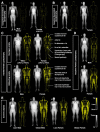Familial Partial Lipodystrophy (FPLD): Recent Insights
- PMID: 32440182
- PMCID: PMC7224169
- DOI: 10.2147/DMSO.S206053
Familial Partial Lipodystrophy (FPLD): Recent Insights
Abstract
Lipodystrophies are a heterogeneous group of congenital or acquired disorders, characterized by partial or generalized loss of adipose tissue. Familial partial lipodystrophy (FPLD) presents with genetic and phenotypic variability with insulin resistance, hypertriglyceridemia and hepatic steatosis being the cardinal metabolic features. The severity of the metabolic derangements is in proportion with the degree of lipoatrophy. The underpinning pathogenetic mechanism is the limited capacity of adipose tissue to store lipids leading to lipotoxicity, low-grade inflammation, altered adipokine secretion and ectopic fat tissue accumulation. Advances in molecular genetics have led to the discovery of new genes and improved our knowledge of the regulation of adipose tissue biology. Diagnosis relies predominantly on clinical findings, such as abnormal fat tissue topography and signs of insulin resistance and is confirmed by genetic analysis. In addition to anthropometry and conventional imaging, new techniques such as color-coded imaging of fat depots allow more accurate assessment of the regional fat distribution and differentiation of lipodystrophic syndromes from common metabolic syndrome phenotype. The treatment of patients with lipodystrophy has proven to be challenging. The use of a human leptin analogue, metreleptin, has recently been approved in the management of FPLD with evidence suggesting improved metabolic profile, satiety, reproductive function and self-perception. Preliminary data on the use of glucagon-like peptide 1 receptor agonists (GLP1 Ras) and sodium-glucose co-transporter 2 (SGLT2) inhibitors in cases of FPLD have shown promising results with reduction in total insulin requirements and improvement in glycemic control. Finally, investigational trials for new therapeutic agents in the management of FPLD are underway.
Keywords: familial lipodystrophy; leptin; lipodystrophy; partial lipodystrophy.
© 2020 Bagias et al.
Conflict of interest statement
Stelios Tigas and Alexandra Bargiota have received travel grants from Aegerion Pharmaceuticals.
Figures


References
-
- Dunnigan MG, Cochrane MA, Kelly A, Scott JW. Familial lipoatrophic diabetes with dominant transmission: a new syndrome. QJM. 1974;43(1):33–48. - PubMed
Publication types
LinkOut - more resources
Full Text Sources
Other Literature Sources

